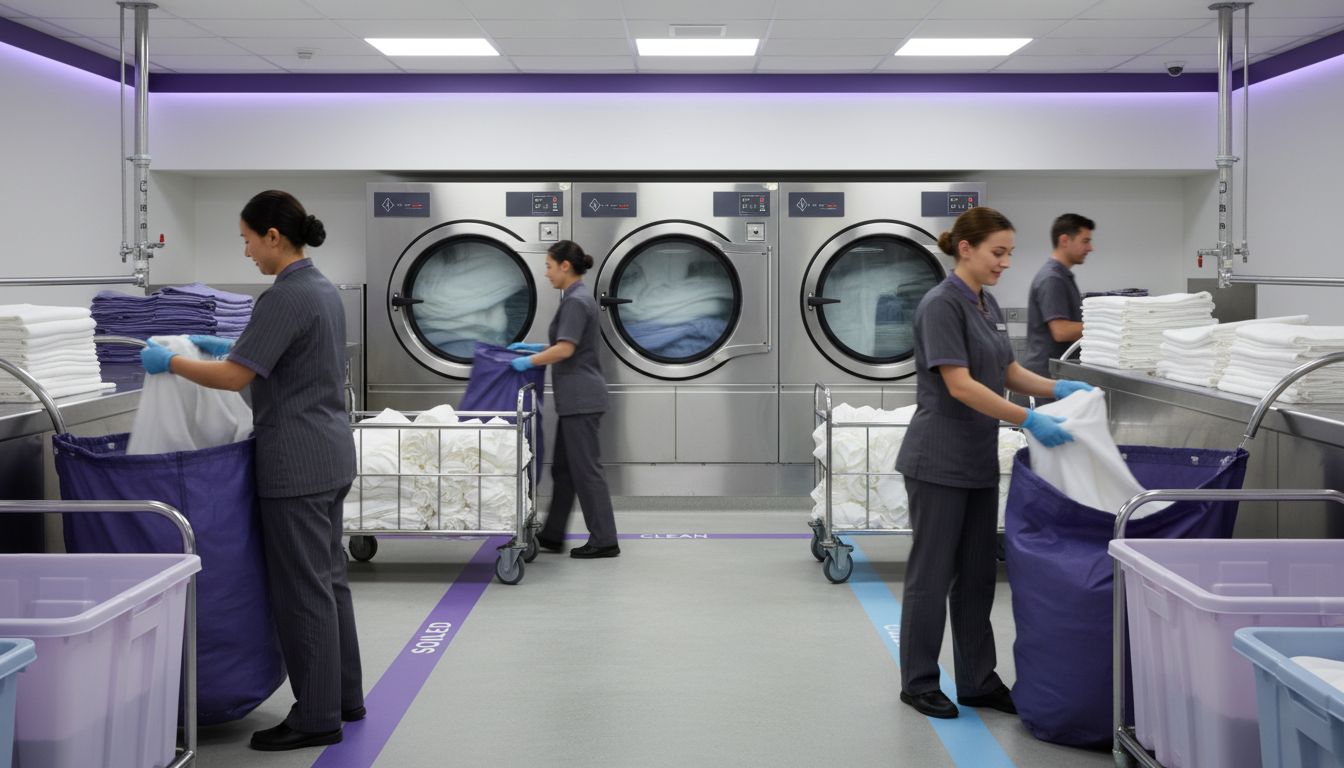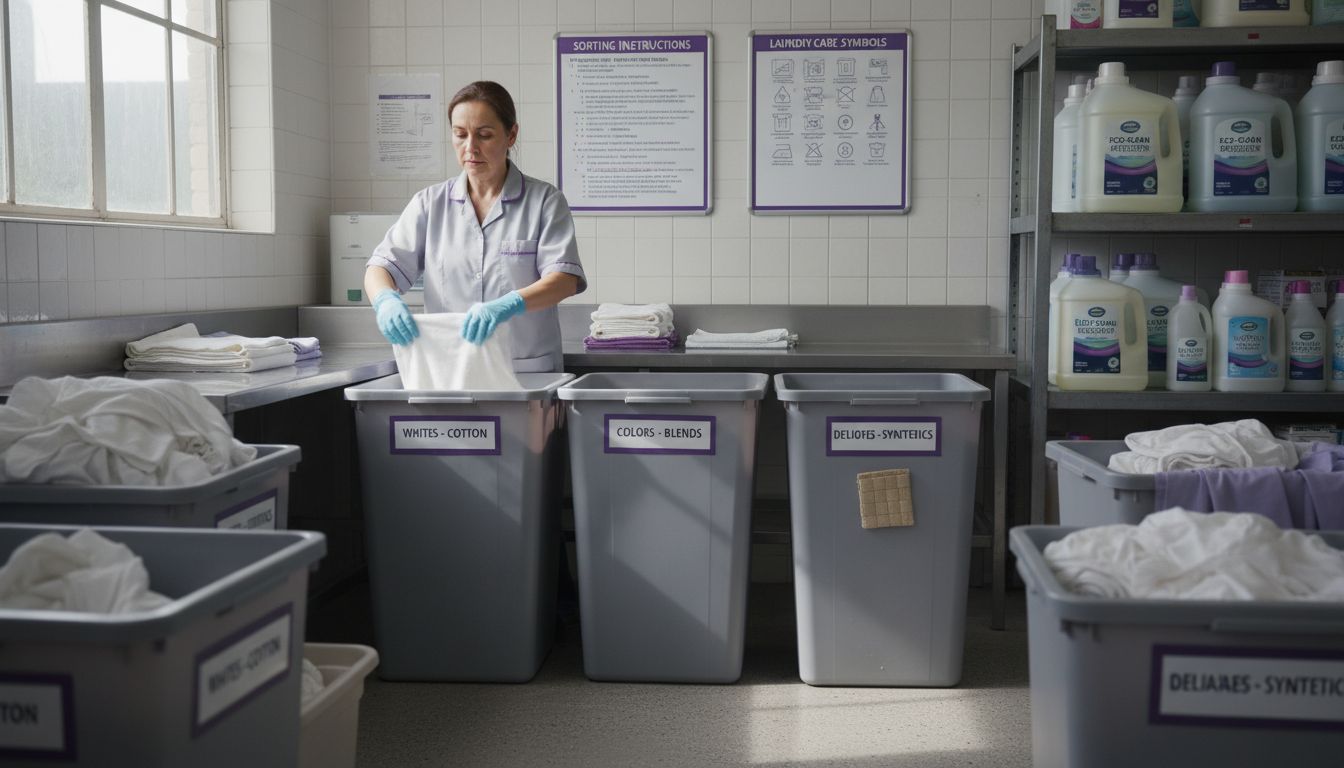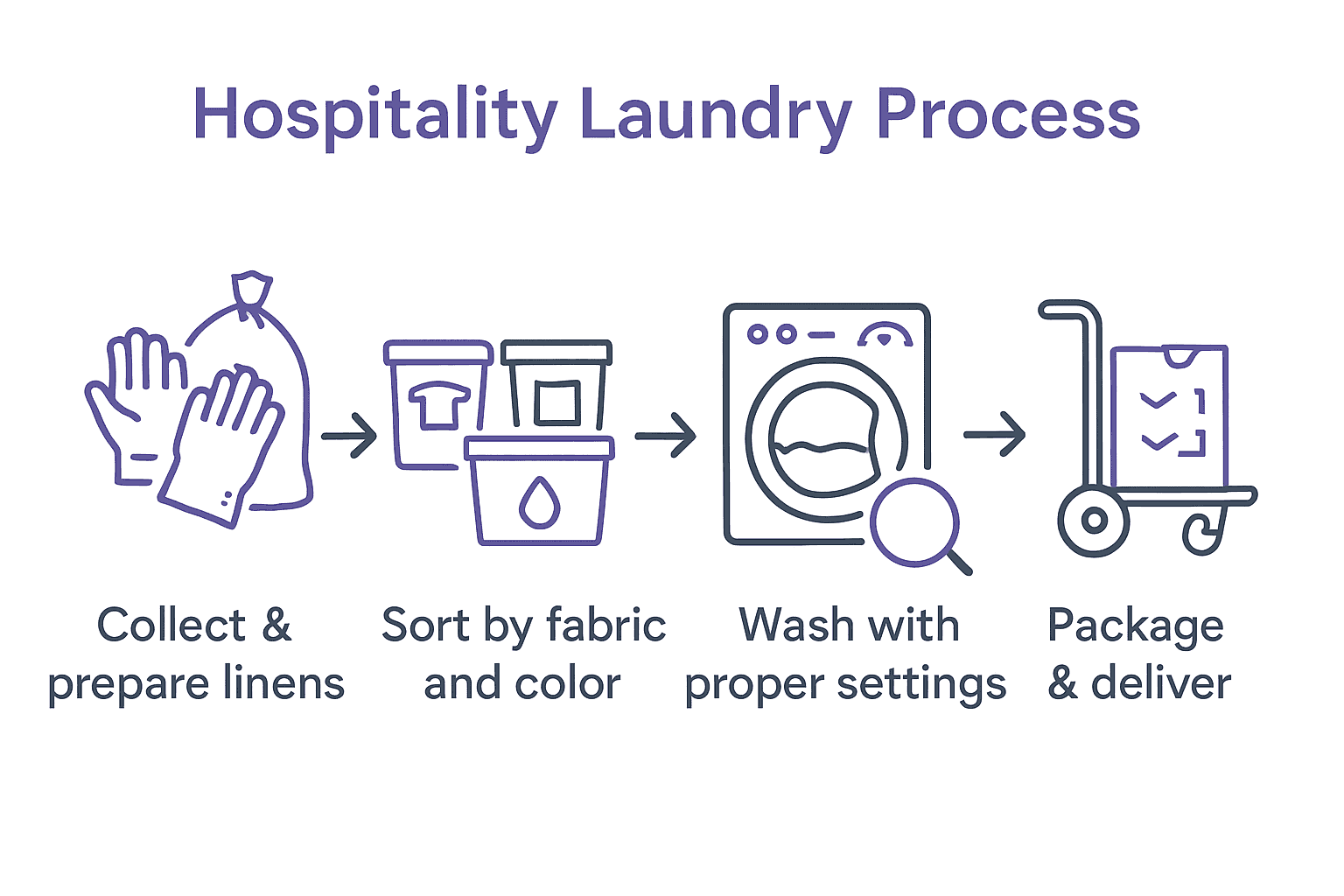Hospitality Laundry Process Guide for Pristine Results
- Sarah Huber
- Nov 19
- 7 min read

Managing laundry in the hospitality industry demands more than just clean linens. With improper laundry practices linked to higher infection risks and customer complaints, every step from collection to delivery matters. Hotels and healthcare facilities handle massive volumes daily, making efficiency and hygiene top priorities. This guide breaks down the process into straightforward steps that help your staff maintain high standards, protect your reputation, and keep operations running smoothly.
Table of Contents
Quick Summary
Key Point | Explanation |
1. Use protective gear for linen handling | Always wear gloves when collecting and preparing soiled linens to prevent contamination and ensure worker safety. |
2. Implement color-coded sorting systems | Organize linens by color and material type using labeled bins to streamline operations and reduce processing errors. |
3. Select washing settings based on fabric | Adjust water temperature and detergent type according to fabric needs for optimal cleaning and prevention of damage. |
4. Inspect linens before delivery | Conduct thorough quality checks for stains and damage to maintain high standards and avoid delivering subpar linens. |
5. Utilize digital tracking for deliveries | Use technology to streamline linen delivery processes, ensuring accuracy and timely distribution, enhancing customer satisfaction. |
Step 1: Collect linens and prepare laundry bags
In hospitality settings, proper linen collection and bag preparation are critical steps that ensure safe, hygienic laundry processing. According to CDC, contaminated textiles require careful handling to prevent potential infection transmission.
To effectively collect and prepare linens, start by designating specific collection areas in each room or service space. Wear protective gloves and use dedicated laundry bags or designated containers for different fabric types. OSHA recommends separating linens by contamination level and material type to maintain safety standards. Carefully roll or fold soiled linens inward to minimize direct contact and reduce potential pathogen spread.
When preparing laundry bags, choose sturdy bags that can withstand transportation without tearing. Securely tie or seal bags to prevent spillage or accidental exposure. For high traffic areas like medical facilities or hotels, color coded bags can help staff quickly identify different linen categories and processing requirements. Always handle soiled linens with minimal agitation and transport them promptly to your laundry processing area to maintain hygiene protocols.
Learn more about optimizing your hospitality laundry workflow in our Laundry Services for Hotels and Hospitality Businesses: Streamlining Your Operations guide.
Step 2: Sort items by fabric and care needs
Sorting linens and fabrics is a crucial step in maintaining their quality and ensuring effective cleaning. According to CDC, proper sorting protects machinery and allows for customized laundry treatments based on specific fabric needs and soil types.
Start by creating distinct sorting categories. Separate items by color white, light, and dark to prevent color bleeding. Divide fabrics by material type such as cotton, silk, synthetic blends, and delicate items. Medical Guidelines emphasize the importance of washing different laundry types separately to prevent cross contamination and maintain optimal cleaning standards. Consider weight and texture as additional sorting factors heavy towels and linens should be grouped separately from lightweight garments to ensure balanced washing cycles.

Pro tip for hospitality staff: Create a color coded sorting system that streamlines your workflow. Use different labeled bins or bags for each fabric category to minimize sorting time and reduce the risk of incorrect processing. By implementing a systematic approach to fabric sorting, you can extend the life of your linens and maintain high quality standards.
For more detailed insights on fabric care, check out our Mastering the Art of Laundry: How to Care for Special Fabrics guide.
Step 3: Select appropriate wash settings and supplies
Selecting the right wash settings and supplies is critical for maintaining the quality and hygiene of hospitality linens. CDC recommends using hot water at 160°F (71°C) for at least 25 minutes to ensure effective disinfection, especially for items requiring thorough sanitization.
Association for the Health Care Environment emphasizes that each linen classification requires a customized wash process. Different fabrics demand specific water temperatures, chemical treatments, and cycle times. For standard cotton linens, use a warm water setting with a heavy duty detergent. Delicate fabrics like silk or synthetic blends need gentler cycles with cooler water and specialized cleaning agents. Always check manufacturer labels for specific care instructions to prevent fabric damage.
Pro tip for hospitality staff: Invest in commercial grade detergents designed for high volume laundering. These specialized products offer superior cleaning power and are formulated to handle the unique demands of hotel and hospitality linens.
Consider using enzymatic cleaners for protein based stains and oxygen based bleach alternatives for maintaining white linens without harsh chemical treatments.
For more comprehensive insights into commercial laundry processes, explore our Step-by-Step Guide to Commercial Laundry Services.
Step 4: Execute washing and drying with care
Mastering the washing and drying process is critical for maintaining the quality and hygiene of hospitality linens. According to the CDC, the antimicrobial effectiveness of laundering depends on a precise combination of mechanical action, thermal treatment, and chemical processes.
Association for the Health Care Environment emphasizes the importance of tailoring drying times and temperatures to specific textile classifications. Begin by loading washers and dryers to about 80% capacity to allow proper fabric movement and even cleaning. Select appropriate cycle settings based on fabric type lighter fabrics require gentler cycles with lower temperatures, while heavy duty linens can withstand more intense washing and drying conditions. Monitor water temperatures and cycle durations carefully to balance thorough cleaning with fabric preservation.
Pro tip for hospitality staff: Implement a systematic approach to load separation. Group similar fabric weights and materials together to optimize washing and drying efficiency. This strategy prevents potential damage from mixing delicate items with heavy fabrics and ensures more consistent cleaning results. Use commercial grade dryers with moisture sensing technology to prevent over drying, which can cause unnecessary fabric wear and reduce linen lifespan.

For more insights on maintaining fabric quality, check out our Keep Your Fabrics Free from Wear: Tips for Maintaining Your Fabrics Between Laundry Visits guide.
Step 5: Inspect items and address quality issues
Quality control is a critical final step in the hospitality laundry process to ensure pristine linens meet the highest standards. Indian Health Service emphasizes that comprehensive laundry services extend beyond cleaning to include thorough inspection, folding, and necessary repairs.
Association for Linen Management recommends a systematic inspection approach. Begin by examining each item under good lighting for potential issues such as stains, tears, discoloration, or fabric weakness. Check for color consistency, especially with white or light colored linens. Separate items that require additional treatment or potential replacement. Pay close attention to high wear areas like edges, seams, and corners where fabric degradation typically occurs first.
Pro tip for hospitality staff: Develop a standardized quality grading system that categorizes linens into reusable, repairable, or replacement groups. This approach helps track linen lifecycle, manage inventory more effectively, and maintain consistent quality across your hospitality operations. Consider creating a quick reference chart that guides staff on acceptable quality thresholds for different linen types and usage contexts.
To learn more about maintaining your linens between professional services, explore our Keep Your Fabrics Free from Wear: Tips for Maintaining Your Fabrics Between Laundry Visits guide.
Step 6: Package and schedule prompt delivery
The final stage of the hospitality laundry process involves careful packaging and timely delivery to maintain the highest standards of cleanliness and professionalism. CDC emphasizes the critical importance of handling clean textiles in a manner that prevents any potential contamination during transport and storage.
Association for the Health Care Environment recommends using dedicated clean linen containers that are regularly sanitized and kept covered. Begin by folding or hanging clean linens carefully to minimize wrinkles and maintain their pristine appearance. Use protective covers or sealed packaging for items that require extra protection. Sort items by type and destination to streamline the delivery process. Organize delivery routes to ensure the most efficient and timely distribution possible.
Pro tip for hospitality staff: Implement a digital tracking system for your linen deliveries. Create a standardized packaging protocol that includes checking item count, quality, and specific delivery requirements for each client. This approach not only ensures accuracy but also helps you quickly identify and address any potential issues before they reach the customer. Use clear labeling and color coded systems to differentiate between different types of linens and their intended destinations.
Discover more about optimizing your delivery workflow in our Mastering the Art of Preparing Your Laundry for Pickup and Delivery guide.
Elevate Your Hospitality Laundry Process with GoGet My Laundry
Managing linens in the hospitality industry demands precision and care at every step from sorting fabrics to inspection and timely delivery. The challenges of maintaining hygiene, preventing fabric damage, and ensuring quick turnaround are real and can cause frustration when not done right. GoGet My Laundry understands these pain points—offering advanced commercial laundry solutions designed to protect your linens while streamlining your workflow with proven care techniques like commercial extractor washers, specialized detergents, and tailored finish options.

Experience the difference of a professional laundry partner who puts your operational needs first. Benefit from flexible scheduling, hypoallergenic and medical-grade soaps, and real-time damaged linen tracking to keep your hospitality business running seamlessly. Ready to simplify premium linen care and delivery? Visit GoGet My Laundry today and discover how our Commercial Services align perfectly with every step of your hospitality laundry process. Take the next step toward pristine linens with the trusted metro Phoenix expert who delivers excellence right to your door.
Frequently Asked Questions
How should I collect linens for laundry in a hospitality setting?
To collect linens safely, designate specific collection areas and wear protective gloves. Use dedicated laundry bags for different fabric types and roll or fold soiled linens inward to minimize direct contact with contaminants.
What is the best way to sort linens by fabric and care needs?
Sort linens by color first—white, light, and dark—to prevent color bleeding. Then, categorize them by fabric type, such as cotton or silk, and consider weight and texture to ensure efficient washing cycles.
What wash settings should I use for hospitality linens?
Use hot water at 160°F (71°C) for at least 25 minutes to ensure proper disinfection. Adjust the wash settings based on fabric type; for example, use gentler cycles for delicate items and heavy-duty settings for thicker linens.
How can I ensure quality control after washing and drying linens?
Inspect each linen item under good lighting for stains, tears, or discoloration. Develop a quality grading system to categorize items as reusable, repairable, or needing replacement to maintain consistent quality in your hospitality operations.
What steps should I take to package and schedule linen delivery?
Package clean linens in dedicated containers that are regularly sanitized and sorted by type and destination. Organize delivery routes efficiently to ensure prompt delivery while keeping linens protected from contamination during transport.
Recommended

Comments